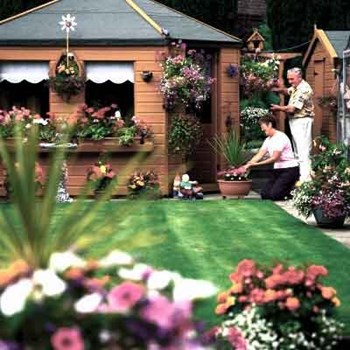
Just as she abhors a vacuum, Nature loathes lawn mowers, weed-whackers, pruning shears, hedge clippers…anything used to control the chaos she prefers. This state of overgrowth and disorder may be nature's default setting, but doesn't make for good landscaping. Planting bulbs and pruning trees may seem easy - or at least fairly straightforward—but there is a complexity to the landscaper's art that belies its natural simplicity. There's a great deal of information to know, a great deal of plant life to manage and a great deal of work to do to make your building or association's grounds look their best.
Plant Planning
Good landscaping, like anything, requires careful planning.
"The two most important elements of a strong landscape maintenance plan are observation and communication," says Sam deTuro, chairman and founder of Woodwinds Associates Inc. in Princeton, who has plied his trade for over 50 years.
Observation involves regular and expert monitoring of the plant life on the premises. Communication means simply relaying the diagnosis to the property owners and managers in a timely fashion. "It sounds corny and trite," he says, "but you want to deal with the little problems instead of the big ones." In other words, an ounce of prevention is worth a pound of cure. Or thousands and thousands of dollars of cure, as the case may be.
Wayne Dubin, vice president and division manager for the nationwide Bartlett Tree Experts in Denville, agrees.
"Regular and routine inspection of plants is critical," he says. "The problem often is that by the time an owner or building manager spots the damage to a tree or shrub, it's already in decline. There may be nothing to do but replace it."
Periodic inspections lessen the chance that things can go awry.
"We can be of so much more value if we're taking care of the plants all along," he says, "rather than just doing a post-mortem."
When an arborist performs and inspection, what is he looking for?
"It's a combination of looking up and looking down," Dubin explains. "We're looking for adequate moisture levels—not too much, but not too little." He adds that this also depends on the plant or tree. Some thrive on a lot of moisture. Others die under the same conditions.
When deTuro says observation, he means it. A number of potential problems can be spotted with a trained eye.
"I look for indications of nutrient deficiencies," he says. "You can tell by the color, size and volume of foliage." These attributes vary according to the season and the species, he says, and can be relative. "You have to look at a Norway maple on the left and on the right to compare color, size and volume," he says. "Unless you've been looking at Norway maples for 50 years."
The way the trunk is planted in the ground is also something to keep an eye on.
"We're looking for excess mulch pile-up—mulch 'volcanoes' piled up at the base are bad for the plant," says Dubin. "The base of the plant should look like an upside-down martini glass—a distinct flare that's visible, not covered in mulch."
Pests, of course, are also something to look out for.
"Mites suck the chlorophyll out of the leaves and needles," Dubin says. "Plants that are under attack have an off-color appearance that can be a red flag," he adds.
The gypsy moth in particular is a problem in the Garden State, deTuro says. Since their accidental importation in 1869, gypsy moths have spread to every county in New Jersey. Their numbers seem to swell according to cycles. "We're in an up-cycle now," he says. And "2006 was a bad year, and 2007 promises to be worse."
Gypsy moths are in the egg stage from August through April. This is when they're easiest to kill, either by scraping the egg sacs off the trees—each sac contains up to 1,000 egg—or painting them with kerosene. Other remedies include wrapping burlap around the trunks or using duct tape coated with tanglefoot, a super-sticky glue that traps crawling and flying insects before they can make their way up the plant and cause trouble.
Once the caterpillars arrive in early May, however, pesticide is the best solution. There are biological pesticides, deTuro says, that aren't as caustic, and if all else fails, chemical ones.
Gentler Alternatives
If deTuro sounds reluctant to employ virulent pesticides, he has good reason.
"Fifty years ago, when I started, we assumed everything was covered with pests. We sprayed everything with four covers of spray—a witches' brew of kill-all chemicals."
These included mercury, DDT, and calcium cyanide, which he points out, is a form of what they use for capital punishment executions.
"We killed everything," he says. "The insects, most of the birds who ate the insects, cats who ate the birds and, unfortunately, some of the applicants that sprayed the stuff."
This extreme practice is no longer followed. What's more, deTuro believes that pests aren't the universal scourge they're made out to be.
"They've made huge innovations in 50 years," he says. "A lot of research and new information—while there may be pests present, the main causes of a plant's decline is man's influence on that plant."
Man's influence is much more pervasive than insects, especially if it's people who have planted the plants to begin with. "As with humans, there is a set of physiological and environmental aspects that influence whether a tree is happy," he says.
These include, among other things: the general climate in the area, exposure to the sun, the amount of sunlight, exposure to wind, exposure to extremes in temperature, drainage and relationships with nearby trees and plants. "There are some trees and plants that aren't compatible in the branch spread or root zone of other species," says deTuro, and manmade structures like underground utility wires, foundations and footings, compacted soil, and excavation play a role as well.
"The basis of most worst-case scenarios begins with the wrong tree in the wrong location," he says, "rather than the right tree in the right location."
Sometimes, the location can be wrong, no matter what the planting. Years ago, deTuro's company was called in by a landscape architect to a job in northern New Jersey. The landscaper had replaced thousands of plants, only to watch them all die over and over.
Eventually, deTuro determined that the site was located on a massive landfill for vegetation—raw garbage, leaves, grass clippings, and so forth.
"Back then," he says, "people thought this was totally harmless."
Needless to say, it's not. As vegetation decomposes, methane gas is produced. Methane gas seeping into the soil is what killed the plants. As far as he knows, they still haven't been able to grow anything there—if, in fact, the land is habitable at all.
Adding Value
How valuable is good landscaping? Some insurance companies are underwriting policies for landscaping, recognizing its value.
Dubin, for one, doesn't feel this is necessary.
"Plants are living things," he says, "so there are no guarantees. It's not like going to a bank and opening a CD and knowing how much interest you'll get in a year. But we provide insurance by providing preventive maintenance. With us, you have a relatively high degree of confidence that you won't have a catastrophic loss."
So it really is true that a pound of prevention is worth a pound of cure. Taking a little extra care with your plantings can make the investment in your home and your community all the more worthwhile.
Greg Olear is a freelance writer and a frequent contributor to The New Jersey Cooperator.





Leave a Comment